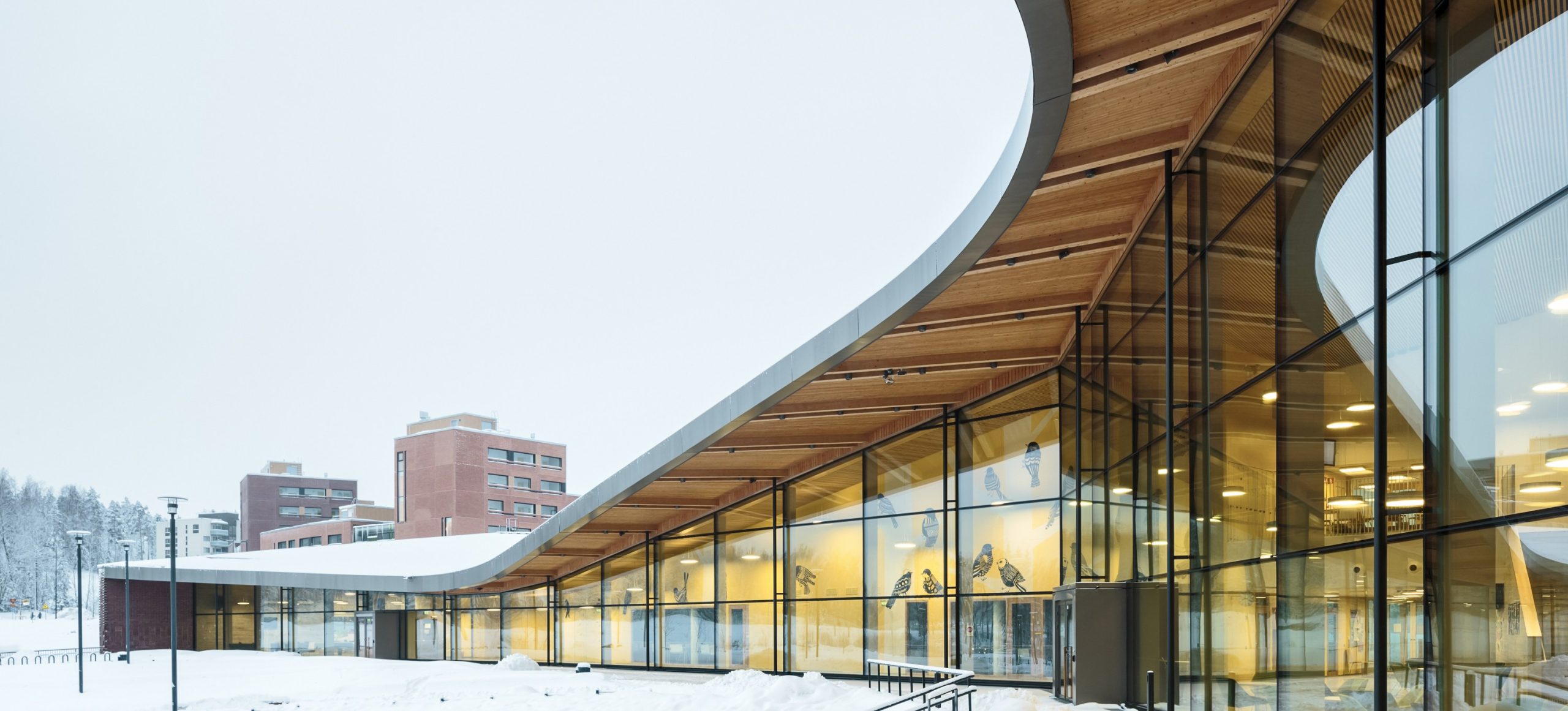Originally published in Monocle’s How to Make a Nation book, 2016.
In a bright, airy corridor, two children are chatting and laughing on a lime green sofa. Nearby, another pair sits happily on a window sill, working together on a maths problem. This is lesson time, Saunalahti-style.
Situated in Espoo, the second largest city in Finland, Saunalahti school was opened in 2012 in a building of glass and brick designed by Verstas architects. It is part of Finland’s new wave of architect-designed schools that includes Strömberg school in Helsinki, Joensuu comprehensive school, and Sipoo upper secondary school.
Formed around a multi-purpose central atrium with high undulating roof and a curved glass façade, the building is fun and flexible. Different sections of the interior are colour-coded for easy navigation, and many of the walls are glass. Each classroom has its own sofa. Fascinating details are everywhere: one staircase is numbered in English to help third-graders to learn the language. “Every space is a learning space,” says vice principle Minna Welin.
The building also includes a nursery, youth centre, and public library. Many facilities are open to the public after school hours. The surrounding area is currently under construction as new residential developments spring up around the school. “Saunalahti will be the heart of the village,” says Welin.
This link with community is fundamental to education in Finland. “Education is security for a small nation,” wrote the 19th-century Finnish philosopher J.V. Snellman and this belief underpinned the introduction of compulsory comprehensive education in the 1970s, following a period of rapid post-war population growth and urbanisation.
Ever since, the underlying principles have been trust (of pupils and of teachers) and equality – regardless of family background, gender, wealth or ability. The right to free basic education for all is enshrined in the constitution. “We are not trying to make the best schools in the world; we are trying to make a good school for everybody” says Sampo Suihko, deputy mayor for Espoo.
While other high-performers such as Korea and Singapore adopt a pressurised, exam-oriented approach, Finland’s education system is far more relaxed. A typical day for a 14 year-old might start at 9am and finish at 1pm. This includes lunch and a fifteen-minute break after every 45-minute lesson. Practical skills and regular contact with nature are highly valued. Students are not assessed against each other, but according to personalised learning plans that they help to devise alongside their teachers and family.
At Saunalahti in particular the emphasis is on collaborative learning. “Learning how to learn” is the phrase on the lips of teachers and administrators alike. Soon all schools in Finland will be adopting this approach. In August 2016, a new core curriculum will be rolled out across Finland that will bring in multi-disciplinary “phenomenon-based learning”, where students study a particular topic – say, climate change – across a range of disciplines such as geography, literature and the sciences. Teachers will collaborate to plan and deliver lessons, as they already do at Saunalahti.
The idea behind the new curriculum is to prepare students for an uncertain future. “The jobs we are training for don’t exist yet,” says Jouni Kangasniemi, senior adviser at the Ministry of Education and Culture. “Nobody knows the future, and the new system allows for that.”
The latest changes are part of a regular process in which the national core curriculum is renewed every ten years. This time it has taken two years and involved some 600 participants – parents and pupils, teachers, administrators, and politicians from different parties. This means stability: methodology and funding allocations may change with a new government, the overall vision does not.
Once the core curriculum has been set on a national level, it is down to municipalities and individual schools to decide how it ought to be implemented. “All major decisions are made at local level,” says Kangasniemi. “The teachers are the experts.”
Sidebar
Finland is increasingly exporting its education expertise. In 2010, Future Learning Finland was conceived to promote Finnish education abroad. Since then, Finnish teachers and officials have provided training and strategy in Canada, Kosovo and Brazil. Finnish games developer Eduplus, came up with Math Ahoy, which is now distributed on millions of devices throughout Spanish-speaking countries, while the University of Jyväskylä has developed a school in Doha, Qatar, with a Finnish-style curriculum. Educators note that it remains challenging to export education system to a different country with its own distinct culture. It must therefore be a two-way relationship and this takes time: “It has taken four generations,” says Jouni Kangasniemi, “for Finland’s education culture to reach the point we are at now.”
In numbers
Top of the class: Finnish students ranked 1st among OECD countries for science in 2006, for reading in 2000 and 2009, and for mathematics in 2003 and 2012.
€268 million: the total value of Finland’s education exports in 2014, according to Tekes, Finland’s funding agency for research, development and education.
1.2 million: total number of students in Finland in 2014, out of a population of 5.4 million
€6,597 million: Finland’s allocation for education and culture in 2014, 12% of the total state budget
August 2016: Finland’s new curriculum comes into force, rolling out “phenomenon-based learning” to all schools across the country.
